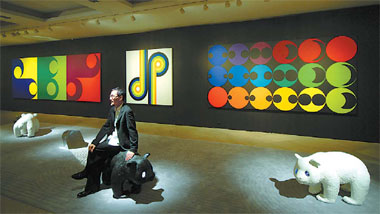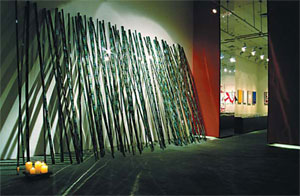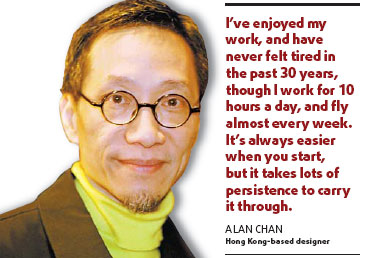"Alan Chan is to the design world what Jackie Chan is to action movies," says a Hong Kong magazine. And they certainly have a point.
The Hong Kong-based designer has just had his first solo exhibition at the Shanghai Art Museum. It was also probably the first exhibition for a designer who is known exclusively for his "commercial projects" at the museum.
"He is like the godfather of designing in Hong Kong," says Zhang Qing, curator of the exhibition, and vice-director of the museum. Chan was invited to the Shanghai Biennale last year, and Zhang had also consulted Chan frequently about the Biennale logo design.
Chan is known as the man who redesigned the Chinese logo of Coca Cola.
Alan Chan at his solo exhibition at the Shanghai Art Museum.
The old design, written in plain Chinese characters, was used for more than 20 years in China. But Chan added some ribbon-like strokes to the writing, making the logo look as fresh and coherent as its English counterpart.
He is also the logo designer for Hong Kong's new airport. His projects can be found in Beijing, Shanghai and Hong Kong. Chan has been invited to become a consultant for the Beijing Olympic Games next year and the Shanghai Expo in 2010. The designer was also the "image ambassador" for a bottled tea company.
Chan's fame is largely built upon his commercial logo designs, using very simple lines and images to define a brand's orientation. But he has explained again and again that he does not only do logos: "I do branding, incorporating the commercial image, as well as shop decoration and company profiles."
One of Alan Chan's early works of installation art on show at the Shanghai Art Museum.
One such example is Fairwood, a Hong Kong-based food and entertainment company. Two years after he modernized their branding design, the company's shares price increased eightfold.
In the past few years, when the Chinese mainland started to realize the value of brand designs, Chan became involved in many projects across the country. An important project in the renovation of Shanghai's Bund area, "Three on the Bund", had all its interior design undertaken by Chan.
"I meet with more difficulties now than in all my past 20 years working in Hong Kong," says Chan about his clients in the mainland. "I was cheated, forced to give up projects, and rejected too, but I always keep on accepting new project plans."
Chan, one of the top-flight commercial designers in China, admitted that he only had 10 months training on design at a night school. "It was a two-year program," Chan says. "I decided to quit after 10 months because I felt the teachers had nothing new to teach me anymore."
Chan believes designing is all about equations. "You design a formula according to the intrinsic quality of the product," he says.
Chan once took the assignment of designing a new look for the cigarette brand "Chunghwa".
"It's a long established brand, with a high marketing orientation," he says.
So he designed a sub-brand series "Chunghwa 5000", creating a new packing box, and thus updated the cigarette brand's image into the 21st century.
When doing projects on the Chinese mainland, Chan also learns the art to communicate with government officials and those involved in the projects.
Chan is one of the top commercial designers in China.
"You need to communicate with them skillfully," he told a complaining artist in Shanghai. "You have to treat them as friends. We can't make them lose face. They will be moved in the end.
"I worked for four different advertising companies in Hong Kong in the 1970s," explains Chan, "and all of them were foreign companies with Western bosses. We Chinese followed their operation. But now we are catching up, showing our local ways and ideas."
Working and making friends with foreigners added to his understanding of Chinese culture. "We may neglect some of our own culture, but foreigners feel it is very fresh and impressive. From them I learned to cherish our culture, and see it from a different point of view."
Zhang, the curator, says Chan was like a child in front of new things, full of curiosity and fresh feelings. Critics say his designs often have a sense of Zen.
Chan has won more than 400 prizes in design. His suggestion for the younger generation dreaming of a career in this field is not to be too influenced by material objects or money.
"I've enjoyed my work, and have never felt tired in the past 30 years, though I work for 10 hours a day, and fly almost every week. It's always easier when you start, but it takes lots of persistence to carry it through."
Chan was born in a working class family. His father had a fruit store in the 1950s. "He used to make furniture from fruit boxes, doing the designs and handicraft himself. I think I learned my skills from him," Chan says.
As a child, he used to make his own toys. During festival seasons, he would be very eager to decorate the house.
He was "fussy" about his own dressing, buying clothes and going to tailors to have them made to his own request. He would especially buy a small piece of cloth to make his own ties in order to match his shirts.
In the 1980s when he designed graphics and images for Hong Kong's pop stars, he used to lend his own clothes to his singing clients. "Leslie Cheung had an album cover photograph wearing my jacket," he recalls about the deceased pop idol. "Later we became friends. I still have a pair of shoes with me, a gift from him."
(China Daily August 3, 2007)





